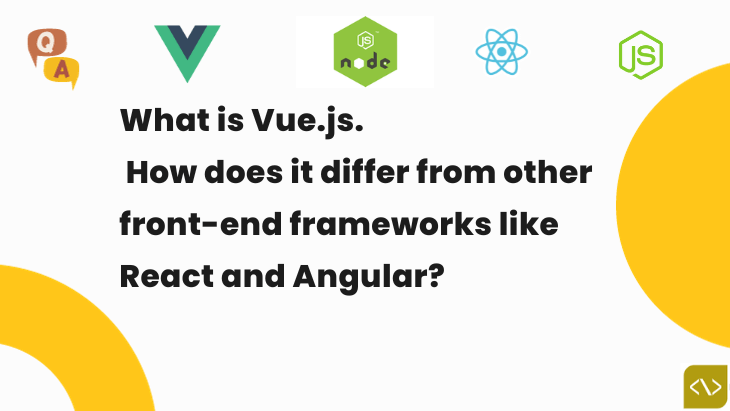
What is Vue.js, and how does it differ from other front-end frameworks like React and Angular?
----------------------------------------------
Vue.js, often referred to as Vue, is an open-source JavaScript framework used for building user interfaces and single-page applications (SPAs). It is designed to be incrementally adoptable and is known for its simplicity and flexibility. Vue is often categorized as one of the three major front-end frameworks, alongside React and Angular, but it has several key differences that set it apart:
1. Approachability:
-
Vue.js: Vue is renowned for its approachability and ease of learning. It has a gentle learning curve and a clear, concise documentation, making it an excellent choice for both beginners and experienced developers. Vue's template syntax, which closely resembles HTML, is easy to grasp.
-
React: React, while powerful, has a steeper learning curve for beginners, particularly with JSX and the concept of a virtual DOM. It requires a more complex setup with tools like Webpack and Babel.
-
Angular: Angular, with its powerful CLI and extensive feature set, can be overwhelming for beginners. It introduces a wide range of concepts and terminologies that may take time to master.
2. Flexibility:
-
Vue.js: Vue offers flexibility by allowing developers to use a combination of templates, JavaScript, and CSS, catering to various development styles. You can gradually adopt Vue in an existing project or start a new project from scratch.
-
React: React provides a high degree of flexibility but places more responsibility on developers to choose and integrate libraries for routing, state management, and other functionalities. This flexibility allows you to tailor your solution to your specific needs.
-
Angular: Angular is an opinionated framework that enforces a specific structure and set of tools. While this can be advantageous for large teams and projects, it may feel less flexible to developers accustomed to other, more modular approaches.
3. Component-Based Architecture:
-
Vue.js: Vue promotes a component-based architecture, similar to React. Components are self-contained, reusable, and can be composed to build complex user interfaces. Vue's single-file components, which encapsulate HTML, CSS, and JavaScript in a single file, are a popular feature.
-
React: React is known for its component-based architecture, where the user interface is broken down into reusable components. React components are primarily defined in JavaScript, and JSX is used to describe the UI structure.
-
Angular: Angular also adopts a component-based architecture. Components are central to Angular development, and the framework enforces a clear separation of concerns through decorators.
4. Integration:
-
Vue.js: Vue can be easily integrated into existing projects, allowing developers to apply it to specific parts of a website or application without a complete rewrite. This incrementality is a core feature of Vue.
-
React: React is also incremental, enabling developers to integrate it into existing applications. React can be mixed with other libraries and is often used alongside tools like Redux for state management.
-
Angular: While it is possible to integrate Angular into existing projects, it's more commonly used to build complete SPAs. Its opinionated nature may make incremental adoption somewhat challenging.
5. Ecosystem:
-
Vue.js: Vue has a growing ecosystem with a set of official libraries and tools, including Vue Router for routing and Vuex for state management. It also has a vibrant community and third-party plugins.
-
React: React has a large and mature ecosystem with a broad range of third-party libraries, such as React Router for routing, Redux for state management, and a variety of UI component libraries.
-
Angular: Angular provides a comprehensive ecosystem, with official tools for routing (Angular Router) and state management (NgRx) and a wide range of official and third-party libraries for various use cases.
6. Size and Performance:
-
Vue.js: Vue is known for its small size and efficient performance, making it a good choice for building fast and lightweight applications.
-
React: React's performance is optimized through a virtual DOM, but the size of applications can vary depending on the choice of additional libraries and tools.
-
Angular: Angular applications can be larger due to the framework's built-in features. It includes features like dependency injection and AoT (Ahead of Time) compilation for performance optimization.
In summary, Vue.js is a JavaScript framework that differentiates itself from React and Angular by its approachability, flexibility, and incrementality. It's a suitable choice for a wide range of developers, from beginners to experienced professionals, and for projects of varying complexity. The choice between Vue, React, and Angular should be based on your specific project requirements, team expertise, and development style.
Categories: Java Script Tags: #ReactJs, #AngularJs, #Vue, #JavaScript,
